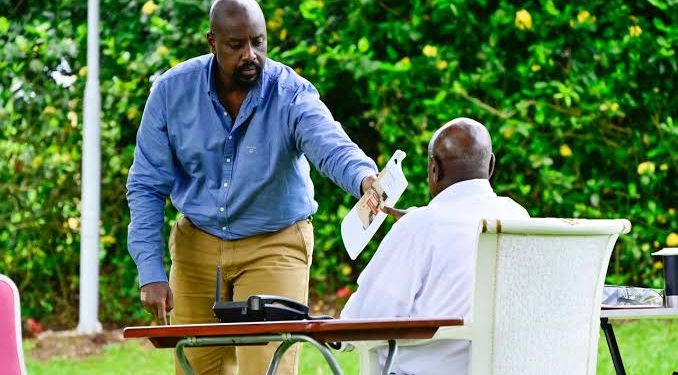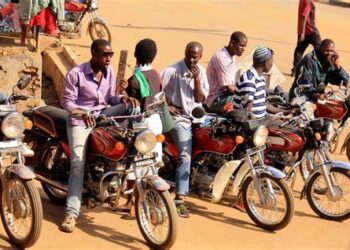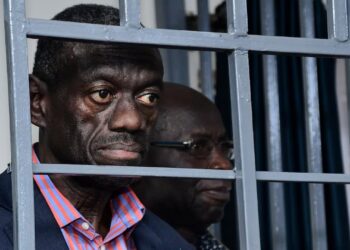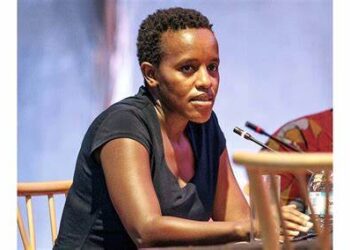By CHANGE OF GUARDS
From his childhood, Uganda’s military dictator, Gen. Museveni, harbored presidential ambitions. Since his student days in the late 1960s, different individuals and groups have been stumbling blocks to his presidential scheme. Since capturing power in 1986 and holding it for the next 38 years, he has continued to face various stumbling blocks. Some individuals and groups have either attempted to wrest power from him or have been perceived to harbor presidential ambitions. His so-called socio-economic mobilization of his tribesmen during his student days was nothing but an avenue for setting up his initial political base. He also intended to portray the Ankole Kingdom as being insensitive to their socio-economic concerns. The January 1971 Idi Amin takeover disrupted his plan of contesting against the then Vice President and Minister of Animal Husbandry, John Babiiha. The latter was the brain behind the establishment of government ranches scheme throughout the country.
During his exile in Tanzania (1971-1979), his scheming to become the face of opposition to the Idi Amin regime saw him undermine other individuals and groups in the same struggle. This included the exiled former president and leader of UPC, Milton Obote, and Jack Maumbe Mukwana, who had mobilized fighters from the eastern region. However, Museveni preferred the dominance of his tribesmen. He also faced challenges from those who had embraced the Idi Amin regime. The elites, the Muslim community in the country, the Catholic Church, the Baganda, and the Banyarwanda immigrants and refugees had no problem with the said regime.
By securing for himself the strategic position of Minister of Defense following the overthrow of the Idi Amin regime in 1979, he intended to use the army to propel himself to the presidency. However, he was kept in check by the likes of Prof. Y. Lule, Godfrey Binaisa, O. Ojok, Paul Muwanga, C. Rwakasisi, and Edward Rurangaranga, who frustrated his efforts to build a private army. Out of desperation and frustration, but more so following the humiliating rejection at the December 1980 polls, he opted to launch his sectarian Bush War in 1981. His four and a half years campaign of terror against Milton Obote and his UPC regime faced challenges. Within his NRA, he faced leadership challenges from the Bahima Commanders led by the likes of Commander Sam Magara and David Tinyafuza.
There was a group of majority Baganda fighters who complained about discrimination. The systematic neutralization of Baganda commanders, including Kakoza Mutale, helped him sail through. Externally, he faced challenges from UPC officials like Milton Obote, Chris Rwakasisi, Paulo Muwanga, Oyite Ojok, Edward Rurangaranga, and others who knew him very well. Another challenge came from Prof. E. Rubumayo and his Gang of Four, with its UNLF-AD armed group under Comdet Chefe Ali. This group unjustly frustrated his scheme of enjoying exclusive recruiting rights of fighters from the western region and the Bahima community in particular. Then there was the Prof. Lule and Andrew Kayiira armed groups that initially threatened to dominate support in the strategic Buganda region. Together with the Moses Ali group in West Nile, these entities enjoyed the then-sole external support from Libya’s Gaddafi. Museveni duped the Prof. Lule group into joining hands with his group to give rise to the NRA. He went ahead to use the few Muslims that he had in his NRA to win the support of Gaddafi. By systematically undermining Kayiira’s UFM, he exclusively enjoyed the much-needed support of the Baganda. The death of the then-army Chief of Staff, Brig. Oyite Ojok, created a big crack in the UNLA.
Still, achieving his childhood ambition was not yet in sight until the Okellos overthrew Milton Obote’s UPC government in July 1985. The joining of hands with the Okellos junta by the armed groups of Kayiira and Moses created a fresh challenge, leading to the infamous Katonga stalemate. However, disaffection among the Baganda fighters was only resolved by manipulating then-Prince Mutebi into visiting the NRA-liberated zone in the western region. With victory in sight, the infamous Nairobi Peace Talks were a welcome relief for Museveni. He used the talks and the resultant ceasefire as an opportunity to strengthen his position for a final assault. However, while Museveni had no trouble manipulating then-President Tito Okello, he had an uphill task dealing with the likes of Paulo Muwanga, Col. Gad Wilson Toko, and Gen. Bazilio Okello, who had mastered his ways. Libya’s Gaddafi was once again at hand to broker an understanding between Museveni and Moses Ali. The latter was to withdraw his troops from Kampala to pave the way for the NRA’s easy advancement and seizure of power in January 1986.
Since taking power, he has had to overcome several obstacles. The West Nile, Acholi, and Teso regions went into rebellion. The UNRF-II and the West Nile Bank Front in West Nile, the UPDM and Holy Spirit Movement in Acholi, and the UPA in Teso were in armed rebellion. The emergence of the LRA led to the total breakdown of diplomatic relations with Khartoum. In Tororo, the FOBA under Aggrey Awori, which had established bases in Kenya, threatened to shatter diplomatic relations. In the central region, the Kirimutu group, the former UFM fighters under Andrew Kayiira, and some Baganda Catholics and DPs plotted to overthrow his government. They were rounded up and charged with treason, and the murder of Andrew Kayiira marked the end of UFM. The cosmetic restoration of the Buganda Kingdom helped tame the agitation by the Baganda. However, individual Baganda like Joseph Lusse, Maj. David Matovu, and others continued to plot rebellion.
The NALU armed group in the Rwenzori mountains lost momentum after its leader, Amon Bazira, was killed in Nairobi. However, its strength was rejuvenated by Col. Ahamad Kashilingi, who had fled the country and set up bases in DRC. The suffocation of the quest for federalism during the 1995 Constitution-making process saw the rise of the NDA armed rebellion under Maj. Herbert Itongwa. The birth of the ADF in 1996 saw the worsening of diplomatic relations with Khartoum. The political opposition, fronted by DP’s Paulo Ssemogerere under IPFC, contested elections against Museveni. He was violently defeated by Museveni’s security apparatus. The 2001 polls saw the political opposition rally behind Dr. Besigye in contesting against Museveni. His extremely violent defeat by security apparatus saw the emergence of the Reform Agenda. Dr. Besigye fled house arrest to exile in South Africa before he was accused of treason. Rwanda, which had been accused of bankrolling Dr. Besigye’s candidacy, was further accused of aiding his shadowy PRA armed rebellion. In the meantime, Joseph Kony’s LRA rebellion in northern Uganda was gaining momentum.
Within his NRA, several individuals continued to seek to wrestle power from Museveni through both constitutional and unconstitutional means. While some of the contenders openly came out, others are simply perceived to harbor presidential ambitions. Gen. Saleh, Gen. Ssejusa, Col. Dr. Besigye, G. Bukenya, Rebecca Kadaga, Noble Mayombo, Gen. Aronda, Gen. Julius Oketta, Col. Ibrahim Abiriga, Gen. Tumukunde, Jacob Oulanya, Andrew Mwenda, Amama Mbabazi, Gen. Katumba Wamala, Gen. Biraro, Gen. Paulo Loketch, Gen. Kaziini, and the list goes on, not to mention Bobi Wine and his perceived backers at Mengo and Rubaga. After successfully taming all those contenders, Museveni is now comfortably scheduled to pass on the presidency of Uganda to his son, Gen. Muhoozi.
INFORMATION IS POWER AND THE PROBLEM OF UGANDA IS MUSEVENISM







Discussion about this post